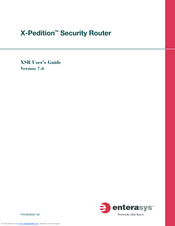Enterasys Security Router X-PeditionTM Manuals
Manuals and User Guides for Enterasys Security Router X-PeditionTM. We have 1 Enterasys Security Router X-PeditionTM manual available for free PDF download: User Manual
Enterasys Security Router X-PeditionTM User Manual (466 pages)
Enterasys Security Router User's Guide
Brand: Enterasys
|
Category: Network Router
|
Size: 5 MB
Table of Contents
-
Getting Help32
-
-
-
-
SNMP Informs75
-
Statistics75
-
-
-
-
-
Overview103
-
-
Proxy DNS106
-
BOOTP/DHCP Relay106
-
Broadcast107
-
Local Broadcast107
-
Icmp107
-
Tcp108
-
Udp108
-
Telnet108
-
Ssh108
-
IP Interface109
-
Secondary IP109
-
Ping112
-
Traceroute112
-
-
Ripv1 and V2113
-
Ospf116
-
Null Interface119
-
Route Preference119
-
Static Routes120
-
VLAN Routing120
-
Qos with VLAN124
-
-
Match Clauses125
-
PBR Cache125
-
Set Clauses125
-
Default Network126
-
Router ID126
-
-
Features128
-
-
VRRP Features132
-
Authentication132
-
Gratuitous ARP133
-
Host ARP133
-
Load Balancing133
-
Proxy ARP133
-
ICMP Ping134
-
-
-
-
-
Configuring NAPT142
-
Configuring NAPT143
-
-
-
Router Xsra147
-
Router Xsrb147
-
-
-
-
Features149
-
Overview149
-
-
Open150
-
Keepalive151
-
Notification151
-
Update151
-
-
-
AS Path152
-
Origin152
-
Local Preference153
-
Next Hop153
-
Atomic Aggregate155
-
Weight155
-
Aggregator156
-
Community157
-
-
-
Community Lists160
-
Filter Lists160
-
Route Maps160
-
Peer Groups162
-
Synchronization164
-
Route Refresh165
-
Scaling BGP166
-
Route Reflectors167
-
Confederations168
-
-
-
-
-
Features177
-
-
-
-
-
Overview191
-
PPP Features191
-
Authentication193
-
Configuring BAP204
-
-
-
Overview209
-
Virtual Circuits209
-
Dlcis209
-
Dtes210
-
Dces210
-
-
Sub-Interfaces215
-
-
-
-
Dialer Interface227
-
Dialer Strings227
-
Dialer Pool227
-
ISDN Callback228
-
-
Dialer Watch240
-
Caveat242
-
-
-
-
ISDN Features265
-
BRI Features266
-
PRI Features266
-
-
-
B-Channels267
-
D-Channel267
-
Security269
-
Call Monitoring270
-
ISDN Trace270
-
-
T1 Pri279
-
Isdn Bri279
-
BRI Leased Line280
-
BRI Leased PPP280
-
-
-
-
Overview283
-
-
Qos with VLAN296
-
Qos on Input299
-
Qos on VPN299
-
-
-
Overview313
-
Features313
-
ADSL Limitations317
-
ADSL Hardware317
-
NIM Card317
-
DSP Firmware318
-
-
ATM Support318
-
Virtual Circuits318
-
Class of Service319
-
OAM Cells319
-
-
Inverse ARP320
-
Qos320
-
Snmp320
-
-
-
VPN Overview323
-
-
Certificates328
-
CA Hierarchies329
-
RA Mode330
-
Pending Mode331
-
Enroll Password331
-
CRL Retrieval331
-
VPN Applications332
-
NAT Traversal333
-
-
XSR VPN Features340
-
Server 1340
-
Server 2340
-
Client340
-
Limitations340
-
-
-
-
Configuring Acls343
-
-
-
AAA Commands348
-
Configuring AAA348
-
-
-
Configuring PKI350
-
-
Branch Office354
-
-
-
Overview of DHCP375
-
Features375
-
How DHCP Works376
-
DHCP Services377
-
-
Lease377
-
-
Scope Caveat379
-
Manual Bindings379
-
-
-
Features387
-
Packet Filtering388
-
Land Attack388
-
Smurf Attack389
-
Fraggle Attack389
-
AAA Services391
-
-
Alarm Logging402
-
Alarms402
-
Authentication403
-
Firewall and NAT404
-
Firewall and VPN404
-
-
-
-
VPN MIB Tables454
Advertisement
